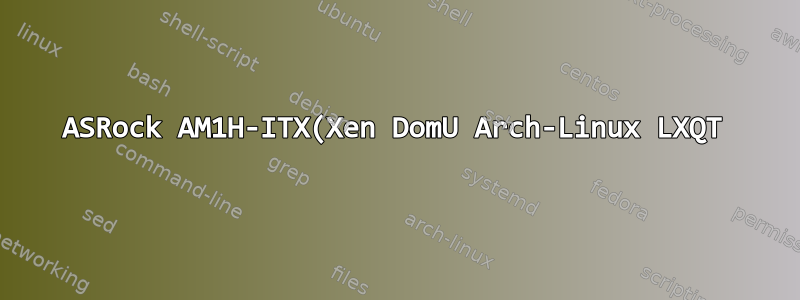%EC%97%90%20Xorg%20%EC%84%A4%EC%B9%98%3A%20startx%20%EB%B0%8F%20%ED%99%94%EB%A9%B4%20%EC%97%86%EC%9D%8C.png)
Dom0: 아치 리눅스
DomU: 아치 리눅스
문제는 DomU가 비디오 카드를 찾을 수 없다는 것 같습니다.
inxi -F (DomU)
System: Host: ArkOS_Dev Kernel: 4.2.5-1-ARCH x86_64 (64 bit) Console: tty 0 Distro: Arch Linux
Machine: No /sys/class/dmi; using dmidecode: dmidecode is not installed.
CPU: Single core AMD Athlon 5350 APU with Radeon R3 (-) cache: 2048 KB
clock speeds: max: 2050 MHz 1: 2050 MHz 2: 2050 MHz 3: 2050 MHz
Graphics: Card: Failed to Detect Video Card!
Display Server: N/A drivers: i128,sis,voodoo,fbdev,ati,ark,glint,nv,mach64,neomagic,vesa,savage,vmware,trident,radeon,s3,siliconmotion,intel,tdfx,nouveau,openchrome
tty size: 151x38 Advanced Data: N/A out of X
Network: Card: Failed to Detect Network Card!
Drives: HDD Total Size: 95.9GB (2.8% used) ID-1: /dev/xvda model: N/A size: 93.7GB
ID-2: /dev/xvdb model: N/A size: 2.1GB
Partition: ID-1: / size: 86G used: 2.6G (4%) fs: ext4 dev: /dev/xvda
Sensors: None detected - is lm-sensors installed and configured?
Info: Processes: 70 Uptime: 1 min Memory: 49.8/1997.5MB Init: systemd Client: Shell (bash) inxi: 2.2.28
inxi -F (Dom0)
System: Host: hypervisor Kernel: 4.2.5-1-ARCH x86_64 (64 bit) Console: tty 0 Distro: Arch Linux
Machine: Mobo: ASRock model: AM1H-ITX Bios: American Megatrends v: P1.20 date: 09/23/2014
CPU: Single core AMD Athlon 5350 APU with Radeon R3 (-UP-) cache: 2048 KB speed: 2050 MHz (max)
Graphics: Card: Advanced Micro Devices [AMD/ATI] Kabini [Radeon HD 8400 / R3 Series]
Display Server: N/A driver: N/A tty size: 151x38 Advanced Data: N/A out of X
Audio: Card-1 Advanced Micro Devices [AMD] FCH Azalia Controller driver: snd_hda_intel
Card-2 Advanced Micro Devices [AMD/ATI] Kabini HDMI/DP Audio driver: snd_hda_intel
Sound: Advanced Linux Sound Architecture v: k4.2.5-1-ARCH
Network: Card: Realtek RTL8111/8168/8411 PCI Express Gigabit Ethernet Controller driver: r8169
IF: enp2s0 state: up speed: 100 Mbps duplex: full mac: d0:50:99:4b:96:e1
Drives: HDD Total Size: 120.0GB (6.5% used) ID-1: /dev/sda model: OCZ size: 120.0GB
Partition: ID-1: / size: 16G used: 5.3G (34%) fs: btrfs dev: /dev/sda2
ID-2: /boot size: 511M used: 40M (8%) fs: vfat dev: /dev/sda1
ID-3: swap-1 size: 2.15GB used: 0.01GB (0%) fs: swap dev: /dev/sda4
Sensors: None detected - is lm-sensors installed and configured?
Info: Processes: 108 Uptime: 0 min Memory: 97.9/927.4MB Init: systemd Client: Shell (bash) inxi: 2.2.28
/etc/xen/Arkos-Dev_PV.cfg
name = 'ArkOS_Dev'
bootloader = "pygrub"
#kernel = "/mnt/arch/boot/x86_64/vmlinuz"
#ramdisk = "/mnt/arch/boot/x86_64/archiso.img"
#extra = "archisobasedir=arch archisolabel=ARCH_201511"
memory = 2048
vcpus = 3
disk = [ "format=raw, vdev=xvda, access=rw, target=/dev/vm_volumes/root.ArkOS_Dev",
"format=raw, vdev=xvdb, access=rw, target=/dev/vm_volumes/swap.ArkOS_Dev"
]
vif = [ 'mac=00:16:3e:49:2b:a1,bridge=xenbr0' ]
root = "/dev/xvda rw"
lspci -v grep VGA(Dom0)
00:01.0 VGA compatible controller: Advanced Micro Devices, Inc. [AMD/ATI] Kabini [Radeon HD 8400 / R3 Series] (prog-if 00 [VGA controller])
sudo xl pci-attach 0 '00:01.0,permissable=1' (Dom0)
Unknown PCI BDF option: permissablelibxl: error: libxl_pci.c:1105:libxl__device_pci_add: PCI device 0:0:1.0 is not assignable
/etc/mkinit.conf(DomU)
# vim:set ft=sh
# MODULES
# The following modules are loaded before any boot hooks are
# run. Advanced users may wish to specify all system modules
# in this array. For instance:
# MODULES="piix ide_disk reiserfs"
MODULES="xen-blkfront xen-fbfront xen-netfront xen-kbdfront"
# BINARIES
# This setting includes any additional binaries a given user may
# wish into the CPIO image. This is run last, so it may be used to
# override the actual binaries included by a given hook
# BINARIES are dependency parsed, so you may safely ignore libraries
BINARIES=""
# FILES
# This setting is similar to BINARIES above, however, files are added
# as-is and are not parsed in any way. This is useful for config files.
FILES=""
# HOOKS
# This is the most important setting in this file. The HOOKS control the
# modules and scripts added to the image, and what happens at boot time.
# Order is important, and it is recommended that you do not change the
# order in which HOOKS are added. Run 'mkinitcpio -H <hook name>' for
# help on a given hook.
# 'base' is _required_ unless you know precisely what you are doing.
# 'udev' is _required_ in order to automatically load modules
# 'filesystems' is _required_ unless you specify your fs modules in MODULES
# Examples:
## This setup specifies all modules in the MODULES setting above.
## No raid, lvm2, or encrypted root is needed.
# HOOKS="base"
#
## This setup will autodetect all modules for your system and should
## work as a sane default
# HOOKS="base udev autodetect block filesystems"
#
## This setup will generate a 'full' image which supports most systems.
## No autodetection is done.
# HOOKS="base udev block filesystems"
#
## This setup assembles a pata mdadm array with an encrypted root FS.
## Note: See 'mkinitcpio -H mdadm' for more information on raid devices.
# HOOKS="base udev block mdadm encrypt filesystems"
#
## This setup loads an lvm2 volume group on a usb device.
# HOOKS="base udev block lvm2 filesystems"
#
## NOTE: If you have /usr on a separate partition, you MUST include the
# usr, fsck and shutdown hooks.
HOOKS="base udev autodetect modconf block filesystems keyboard fsck"
# COMPRESSION
# Use this to compress the initramfs image. By default, gzip compression
# is used. Use 'cat' to create an uncompressed image.
#COMPRESSION="gzip"
#COMPRESSION="bzip2"
#COMPRESSION="lzma"
#COMPRESSION="xz"
#COMPRESSION="lzop"
#COMPRESSION="lz4"
# COMPRESSION_OPTIONS
# Additional options for the compressor
#COMPRESSION_OPTIONS=""
답변1
나도 이 길을 갈 것 같다. 저는 방금 AMD Athlon 5150 시스템(Radeon HD 8400 그래픽이 통합된 Athlon 5150)을 구입했습니다. Dom0/DomU가 Arch Linux라고 말할 수는 없지만 데비안의 경우 이는 해결책처럼 보입니다.
AMD/ATI Proprietary Driver
https://wiki.debian.org/ATIProprietary
Google에서 "AMD/ATI 독점 드라이버" 및 "Arch Linux"를 검색하면 다음 두 가지 유망한 페이지가 나옵니다.
AMD Catalyst - ArchWiki - Arch Linux
https://wiki.archlinux.org/index.php/AMD_Catalyst
ATI - ArchWiki
https://wiki.archlinux.org/index.php/ATI


